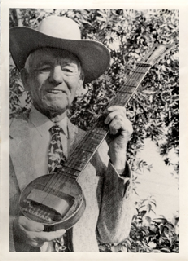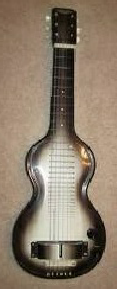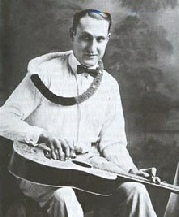




Also in 1950, the spelling of Rickenbacher was changed to Rickenbacker. By the time the spelling was changed, over 1 million Bakelite electric instruments had been sold. The Hawaiian lap steel guitar accounted for a majority of the sales.
In the early 1950’s, the American music scene changed dramatically. The guitar market also changed. The electric Spanish guitar became popular and the sales of
the Rickenbacker non-
Adolph Rickenbacker Sells Electro String To F.C. Hall
In 1953 Adolph Rickenbacker, who had invested over 150 thousand dollars in Electro
String, sold his interest to successful electronics parts distributor F.C. Hall.
Hall had provided financial backing for the production of Leo Fender’s guitars and
amplifiers. In 1946 he became the exclusive distributor for Fender’s guitars and
amplifiers. He was one of the first to fully recognize the business potential of
amplified music. Hall’s goal was to create an in-

pursue his marketing and production goals. This marked the end of the Adolph Rickenbacker era. The modern era of Rickenbacker Guitars was born.
Adolph Rickenbacker continued his varied successful business interests after selling Electro String Corporation. In his later years, he visited the Rickenbacker Factory frequently, taking great pride in the accomplishments the firm had achieved. On March 7, 1976, 24 days before his
90th birthday, Adolph Rickenbacker died from acute circulatory failure after a courageous battle with cancer. A motivated man of high intelligence and foresight, his innovations and contributions to the music industry live on. The Electric Guitar is truly an American Invention which was developed by men of vision, like Adolph Rickenbacker.
The First Solid Body Electric Guitar
Adolph Rickenbacker continued to operate his tool and die business as well as his interest in The National String Company. In 1935, Electro String Corporation released the Model B Electro Spanish guitar, which is credited as the first solid body electric guitar. Of all the instruments that The Electro String Corporation produced, this guitar had the most historical significance for Rickenbacker. The Model B Bakelite Spanish guitar had a bolt on neck and the thick bakelite structure eliminated acoustic feedback, which was a major obstacle. This was a large step forward in innovative solid body guitar designs.
Bakelite mandolins, bass violas, violins and cellos also went into production. After exposure at the New York Trade Show, sales volume increased substantially. It is

estimated that by 1940 over 100 thousand Bakelite electric instruments had been sold.
In
1942 (World War II), Rickenbacker answered the country’s call and stopped producing
musical instruments. Their production facilities were expanded and retooled to manufacture
needed goods for the war effort. When the war was over, they returned to producing
musical instruments.
The Hawaiian lap steel guitars were in demand well into the 1950’s,
with the Bakelite versions being the most popular. The Bakelite Model B, later renamed
B D, was made in two scale lengths, a 22½ inch scale and a 25 inch scale. Six string
and seven string versions were also sold.
The Electro String Corporation
Adolph Rickenbacker became the president of Ro-
American households that did not have electricity. However, in spite of these obstacles, the company sold 13 guitars in their first six months of production.
These guitars were difficult to keep in tune as the heat from the stage lights would cause the aluminum bodies to expand. To solve this ongoing problem, Rickenbacker began to build the guitars out of the synthetic plastic Bakelite instead of aluminum. This innovative move set the course for production of the solid body electric guitar.

Rickenbacker Guitar History
Adolph Rickenbacker was an innovative machinist, tool and die maker and a highly skilled production engineer. Swiss born in 1886, Adolph came to the United States at a young age with relatives after the death of both of his parents. He originally landed in Wisconsin, but wound up settling in Los Angeles in 1918.
The Rickenbacker Manufacturing Company
In 1925, Adolph Rickenbacker and two associates formed the Rickenbacker Manufacturing
Company, where they owned one of the largest deep-
Rickenbacker Manufacturing Company contracted with George Beauchamp of The National String Company in 1928 to produce metal bodies and aluminum resonators for their lap steel guitars. Adolph became friends with Beauchamp and bought National String Company stock. He also became the company engineer and under his guidance production was boosted to 50 guitars a day.
The First Electric Guitar
Using horseshoe magnets and coiled wire, George Beauchamp created a magnetic field
that would convert a guitar string vibration into an electric current. Today, we
call Beauchamp’s creation the electric magnetic pickup. He then designed a wooden
body and the A-
Adolph Rickenbacker And George Beauchamp Form The Ro-Pat-In Corporation
By this time George Beauchamp had left The National String Company. He teamed up
with Adolph Rickenbacker and other investors in 1931 to form Ro-

was the first company on record established for the explicit purpose of producing and marketing electric guitars and amplifiers. They also developed and sold magnetic pick up assemblies that fit acoustic archtop guitars.